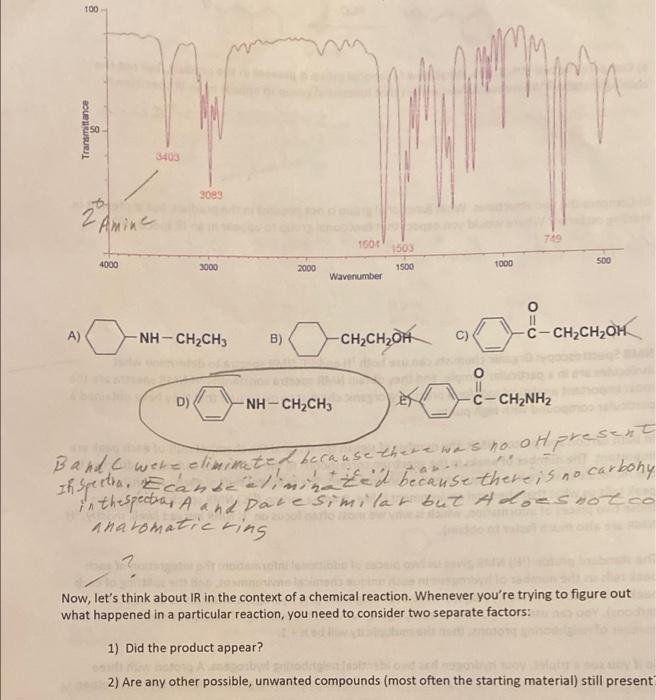Answered step by step
Verified Expert Solution
Question
1 Approved Answer
please answer all parts of question #3... a.identify b. justify c.1. did the product appear? d.2. Are there any other....? thank you please answer all
please answer all parts of question #3... 
a.identify
b. justify
c.1. did the product appear?
d.2. Are there any other....?
thank you

please answer all parts and justify your answer
100 Trans Mance 3403 3083 2 Amine 100+ 749 1503 4000 500 3000 1000 2000 1500 Wavenumber A) NH-CH2CH3 "O ao i B) -CH2CH2OH C) C- CH CH OH 8 D) NH-CH2CH3 C-CH2NH2 Band C were eliminated because there was no ot present zh specta, Ecanda elminated because there is no carbony Spettare the spectra, A and Dale similar but Adoes not co 14 anaromatic ring Now, let's think about IR in the context of a chemical reaction. Whenever you're trying to figure out what happened in a particular reaction, you need to consider two separate factors: 1) Did the product appear? 2) Are any other possible, unwanted compounds (most often the starting material) still present 3) Which of the following molecules would match the IR spectrum shown? Justify your answer. 100 Traino 2 Amine 50 1500 4000 1000 2000 1000 Warunter 0 A) -NH-CH-CH3 B) O -CHCHOH C) -C-CH2CH2OH D) NH-CH2CH3 Dolcom C-CH2NH2 Barde were elimim te leraase there was no ot presenting si spertoa, Ecanda 2 mal because there is no carbonyl In the spectra, A and Date similar but Adoes not conta anaromatic ring Now, let's think about IR in the context of a chemical reaction. Whenever you're trying to figure out what happened in a particular reaction, you need to consider two separate factors 1) Did the product appear? 2) Are any other possible, unwanted compounds (most often the starting material still present? Both of these are important (although students generally focus only on the first question) - we want to make sure that our product is not just present, but pure. 4) Examine the following chemical reaction, noting the bonds broken and the new bonds that are made. 3 also please answer the two follow ip questions thank you very much! 

Step by Step Solution
There are 3 Steps involved in it
Step: 1

Get Instant Access to Expert-Tailored Solutions
See step-by-step solutions with expert insights and AI powered tools for academic success
Step: 2

Step: 3

Ace Your Homework with AI
Get the answers you need in no time with our AI-driven, step-by-step assistance
Get Started


